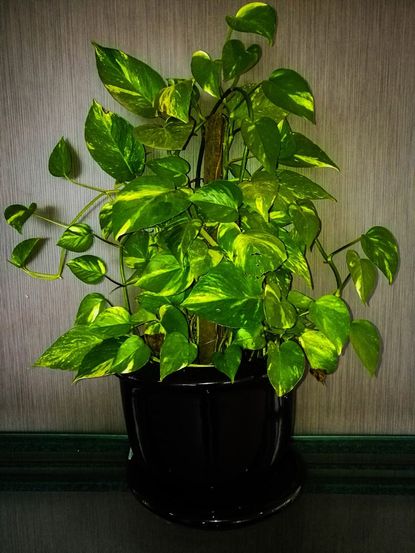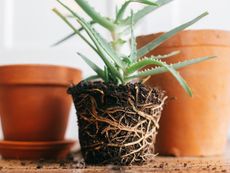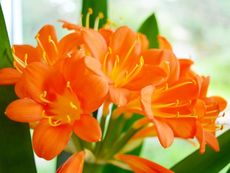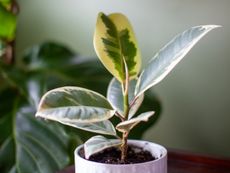What Plants Humidify The Air: Learn About Houseplants That Increase Humidity

Increasing the humidity in your home can benefit your respiratory and skin health and can help prevent nosebleeds, especially in wintertime or in dry climates. Using natural humidifying plants is a great way to increase the humidity in your home while beautifying the indoor environment. Plants constantly pull water from the soil so that they can keep all their aboveground parts hydrated. Some of this water ends up in the plant’s cells, but most of it evaporates into the air from the leaves. We can use this to naturally humidify our homes.
Transpiration of Houseplants
When the air is relatively dry, a plant acts almost like a straw. Dry air creates a “pull” that brings water from the soil into the roots, through the stems, and up to the leaves. From the leaves, the water evaporates into the air through pores called stomata. This process is called transpiration. Growing plants use transpiration to maintain a constant movement of water through the plant. Transpiration delivers water and associated nutrients up to the leaves, and it helps the plant cool down too.
Plants That Add Humidity to Home
So, what plants humidify the air? Nearly all plants add some humidity, but some are much better humidifiers than others. In general, plants with large, broad leaves (like many rainforest plants) provide a greater humidifying effect than those with needle-shaped or small, rounded leaves (like cacti and succulents). Large leaves allow plants to absorb more light and carbon dioxide for photosynthesis, but they also allow more water loss to the atmosphere. Therefore, desert plants typically have small leaves with minimal surface area to conserve water. Plants in rainforests and other environments where water is abundant, but light can be scarce, are typically large. We can take advantage of this pattern to humidify our houses using rainforest plants and other large-leaved plants. Houseplants that increase humidity include:
For more ideas, look for tropical plants with large leaves such as:
Increasing air circulation around your houseplants will also help them humidify the air more efficiently. Make sure your plants are watered well to maximize the humidity they provide but be sure not to overwater them. Overwatering won’t increase transpiration rates, but it will make the plants susceptible to root rot and other problems and could kill the plant. Also, don’t add so many plants that you raise humidity levels past what is healthy for your furniture and appliances.
Gardening tips, videos, info and more delivered right to your inbox!
Sign up for the Gardening Know How newsletter today and receive a free download of our most popular eBook "How to Grow Delicious Tomatoes."
Ilana Goldowitz Jimenez is a scientific and agricultural writer with a B.S. in Plant Sciences from Cornell University and a PhD in Chemical Biology and Infectious Disease from Harvard University.
-
 How To Get Rid Of Mosquitoes In The Garden: 9 Natural Ways To Make Them Buzz Off!
How To Get Rid Of Mosquitoes In The Garden: 9 Natural Ways To Make Them Buzz Off!How to get rid of mosquitoes is on the minds of people in the summer in almost every region of the world. Learn how to repel the pests without toxic chemicals.
By Mary Ellen Ellis
-
 Monkey Orchid Care: How To Grow This Fascinating Species
Monkey Orchid Care: How To Grow This Fascinating SpeciesThe monkey orchid bears a remarkable resemblance to its namesake and, with a little know-how, can be successfully grown as a houseplant.
By Bonnie L. Grant
-
 8 Easy Care Houseplants That Live A Long Time
8 Easy Care Houseplants That Live A Long TimeClick here to learn about our 8 favorite low maintenance houseplants that can, with proper care, live a long time.
By Amy Grant
-
 How Often Should You Repot Plants?
How Often Should You Repot Plants?Escaping roots and shrinking leaves may mean your plant wants a new pot, but some like staying cramped and cozy.
By Mary Ellen Ellis
-
 Orange Flowering Houseplant Varieties With Tropical Flair
Orange Flowering Houseplant Varieties With Tropical FlairClick here to learn about some cheerful orange-blooming houseplants you can try growing.
By Mary Ellen Ellis
-
 Variegated Houseplants With Lovely Leaves
Variegated Houseplants With Lovely LeavesWhat are some of the best variegated houseplants to add to your collection? Click here to find out.
By Amy Grant
-
 Lovely, Lacy Indoor Foliage Plants
Lovely, Lacy Indoor Foliage PlantsClick here to learn about some houseplants with lacy foliage to add to your collection.
By Mary Ellen Ellis
-
 Best Christmas Houseplants And Plants For Winter Holidays
Best Christmas Houseplants And Plants For Winter HolidaysClick here for an idea of the best houseplants to use for holiday décor for Christmas, Hanukkah, Kwanzaa, and New Year’s.
By Laura Miller
-
 Best Big Houseplants To Create An Indoor Oasis
Best Big Houseplants To Create An Indoor OasisIf you have the space you may want to grow some large houseplants. Here are some ideas.
By Mary Ellen Ellis
-
 Relaxing Plants To Grow Indoors For A Calmer Mind
Relaxing Plants To Grow Indoors For A Calmer MindAre there houseplants that can help you to relax? Click here to find out.
By Laura Miller